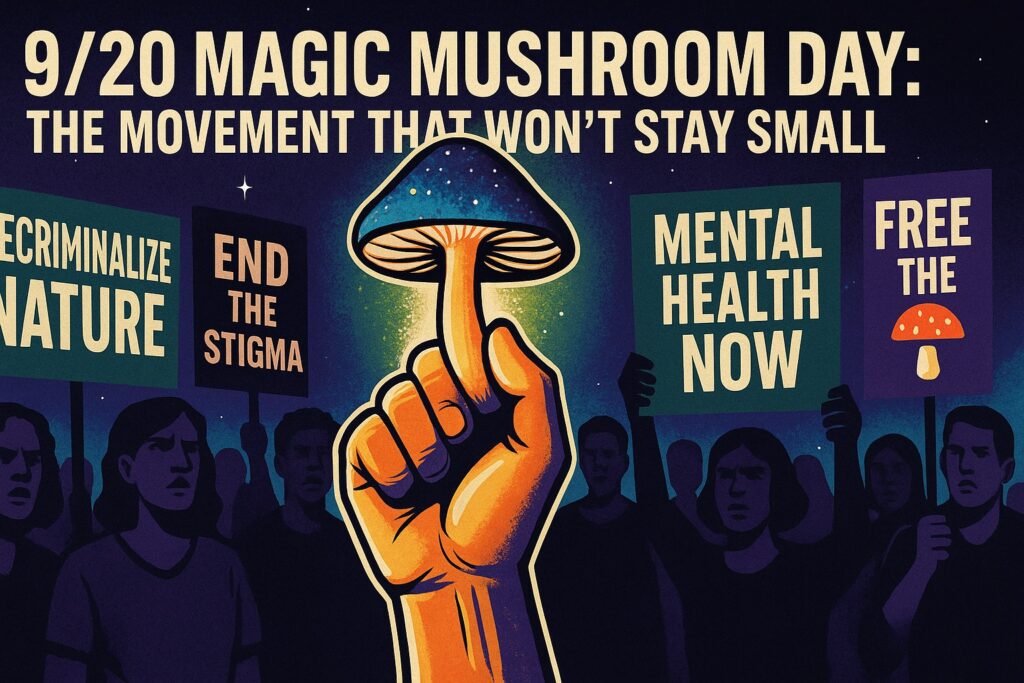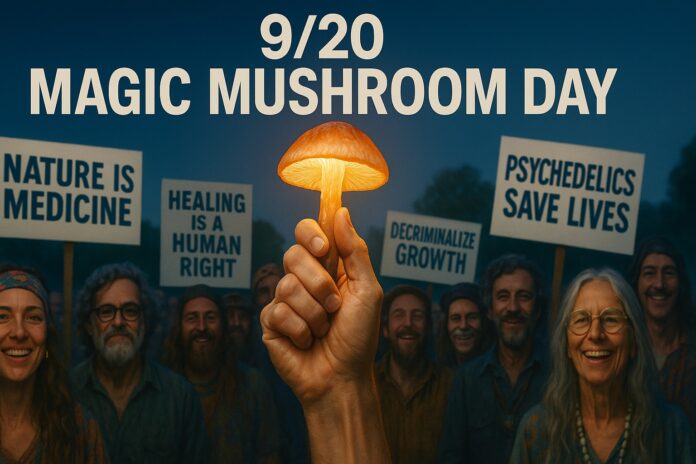Cannabis has 4/20. LSD has Bicycle Day. Psilocybin mushrooms now have their own mark on the calendar: Magic Mushroom Day. What started quietly in small circles has become a cultural event that grows each year. From grassroots rallies and integration circles to memes, art, and academic conferences, this date now serves as a gathering point for people drawn to the possibilities mushrooms represent.
The rise of Magic Mushroom Day mirrors the spread of mycelium itself: invisible at first, then suddenly everywhere, connecting communities that once felt isolated.
How It All Began
The early observances of Magic Mushroom Day were modest. Friends met in apartments to share stories, artists held informal exhibitions, and online communities used coded language to celebrate without drawing unwanted attention. No clear founder can be identified, but the date gained traction through repetition and symbolism, especially as psilocybin research reemerged in the 2000s.
As cannabis activism used 4/20 to amplify its message, mushroom advocates found inspiration. The idea that psilocybin deserved a dedicated day resonated quickly, and by the mid-2010s the movement was visible enough that journalists and researchers started acknowledging it in public conversations.
The Research Driving Recognition
The cultural expansion of Magic Mushroom Day is inseparable from the resurgence of scientific work on psilocybin. Over the past two decades, research teams at Johns Hopkins, Imperial College London, and other universities have published striking results:
- Depression: Patients resistant to standard medication experienced relief in carefully guided psilocybin therapy.
- End-of-life distress: Terminally ill participants reported a profound easing of anxiety.
- Addiction: Early trials showed decreased dependency on tobacco and alcohol.
- Neuroscience: Brain scans revealed unusual patterns of connectivity under psilocybin, sparking debates about consciousness itself.
Each study, often released around September, gave more credibility to the movement. Magic Mushroom Day became not only a cultural ritual but also a time when scientific legitimacy was broadcast to a wide audience.
Celebration Beyond Consumption
Although mushrooms are at the center, the holiday isn’t narrowly focused on ingestion. Many participants see it as a broader opportunity to connect with nature, creativity, and community.
Some cities host art festivals with mushroom motifs. Others arrange guided hikes or ecology talks that emphasize fungi’s role in sustaining life. Online, people share playlists, essays, and digital art inspired by the psychedelic experience. Integration circles allow individuals to discuss long-term effects of past journeys rather than promoting use on the day itself.
This flexibility makes the date accessible. People who have never taken psilocybin can still feel part of the celebration by engaging with its art, science, and symbolism.

The Digital Wall: Hashtags, Emojis, and Search Visibility
For a holiday fueled by online connection, digital censorship has become one of the biggest hurdles.
- Instagram and Facebook: Hashtags like #psilocybin, #magicmushrooms, and even the 🍄 emoji connected to psychedelic content are often blocked or shadowbanned.
- TikTok: Videos mentioning psilocybin vanish within hours, even when they focus on harm reduction or history.
- Google: Search algorithms sometimes bury independent coverage under generic wellness results. Ads for even educational content are disallowed under “drugs and paraphernalia” rules.
This uneven enforcement leads to a strange contrast: mainstream outlets can publish stories about clinical trials without penalty, while independent educators, artists, or grassroots activists struggle to reach their communities.
How Communities Respond
To adapt, mushroom advocates experiment constantly:
- shifting conversations to Telegram, Mastodon, or encrypted groups,
- using coded terms (“🍄 day,” “myco holiday”) to slip past filters,
- investing in newsletters and podcasts outside algorithmic control,
- launching coordinated appeals when hashtags are suppressed.
Rather than silencing the movement, these restrictions have become proof of its vitality. The harder platforms push back, the more creative strategies emerge.
Political Pressure and Policy Shifts
On the ground, Magic Mushroom Day has turned into a tactical date for activism. Each year, petitions circulate, rallies gather, and policy discussions resurface.
Recent milestones include:
- Denver, Oakland, Santa Cruz, Seattle: early decriminalization measures.
- Oregon: supervised psilocybin therapy legalized through ballot initiative.
- Canada: exemptions granted for end-of-life therapy.
- Brazil, Jamaica, Netherlands: legal or gray-area retreats attracting international attention.
These advances often spark renewed campaigns in other regions. Organizers time press releases, op-eds, and city-council pushes around Magic Mushroom Day, ensuring the date carries political weight.
Building Coalitions
One lesson from past years is clear: progress happens faster when movements overlap.
- Mental health advocates highlight therapy benefits.
- Veterans’ groups frame psilocybin as a tool against trauma.
- Indigenous leaders remind audiences of ancient traditions.
- Environmental activists point to fungi’s ecological role.
When these voices converge, the message broadens. Instead of a niche subculture, Magic Mushroom Day becomes a symbol of interconnected causes — health, justice, spirituality, environment.
Indigenous Roots and Ethical Questions
Long before modern activists, psilocybin was used in ceremonies across the Americas and beyond. Mazatec healers in Mexico, for example, integrated mushrooms into rituals of healing and divination.
Today, many organizers use Magic Mushroom Day to honor these traditions. Events may include land acknowledgments, cultural education, and partnerships that funnel resources back to indigenous communities. Activists warn against reducing mushrooms to a Western wellness commodity while ignoring their cultural lineage.
This grounding in history gives the holiday more legitimacy. It connects present activism with centuries of spiritual and medicinal use.
Lessons From Campaigns
Not every effort has succeeded. Some lessons stand out:
- Localized wins: City campaigns often succeed faster than national pushes, as seen in Denver’s breakthrough vote.
- Narratives matter: Personal testimonies — veterans finding peace, patients easing anxiety — resonate more than statistics alone.
- Over-commercialization backfires: Retreats seen as profit-driven without community benefit have drawn criticism.
- Diversification is survival: Campaigns relying solely on censored platforms lose momentum; those spreading across podcasts, zines, and local events remain resilient.
Activists describe this work as iterative: steady pressure, constant adaptation, and a willingness to learn from setbacks.
Global Spread
Although the United States has been a focal point, Magic Mushroom Day is gaining international presence. In Amsterdam, art collectives host exhibitions tied to the holiday. In São Paulo, musicians organize concerts blending indigenous traditions with electronic soundscapes. Online, Spanish- and Portuguese-speaking communities share translations of research papers, widening the conversation beyond English.
The holiday now functions as a global mycelial network of sorts, with local expressions adapting to cultural context.

A Look Ahead: Imagining 2035
Imagine a future Magic Mushroom Day twenty years from now. Licensed clinics in major cities host open houses to explain psilocybin therapy. Parks fill with mushroom-themed parades. Universities time their latest brain-imaging studies to coincide with the cultural spotlight. Families set up picnics under glowing installations while artists cover walls with fungi-inspired murals.
Governments that once resisted now issue official statements highlighting mental health milestones. Search engines promote harm-reduction resources rather than burying them. The movement that began as a whisper has matured into a full-fledged cultural holiday.
Why the Day Matters
Magic Mushroom Day stands at the crossroads of science, activism, and culture. It is a chance for communities to push back against stigma, to share stories of healing, to demand policy reform, and to celebrate creativity.
Each year, more participants join in — whether through marches, integration circles, art, or simply a post with a mushroom emoji. The growth is visible, the energy unmistakable.
Like the mycelium that links forests underground, this holiday keeps weaving connections. It carries the weight of history, the urgency of reform, and the spark of imagination about where human consciousness might go next.
